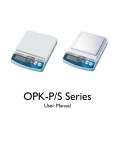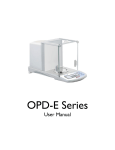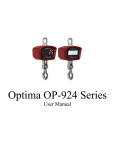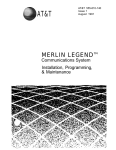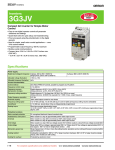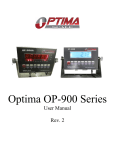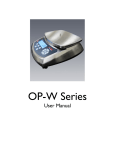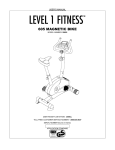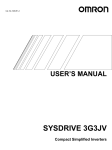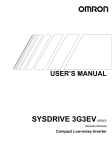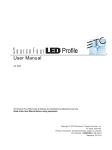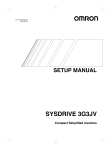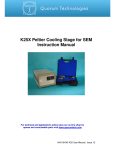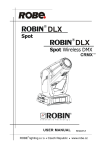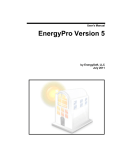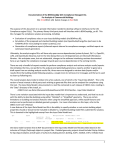Download to manual
Transcript
OPD-A Series User Manual Warnings • Avoid using the balance in any harsh environment. • Only trained professionals are allowed to do repair work. • Turn power off before connecting/disconnecting the power source. • Avoid overloading or dropping material onto the platform as that could damage the balance. • Do not spill liquids on the balance as that could damage the balance. • Material that has a static charge could influence the performance of the balance. • Electromagnetic interference can affect the reading of the balance. • Unplug the power before cleaning and use a piece of soft cloth (do not use any aggressive cleaning agent); Make sure no liquid enters the balance. OPD-A Series User Manual / Table of Contents Getting Started .....................................................................................4 Overview ................................................................................................................................4 Contents .................................................................................................................................5 Preparation ............................................................................................................................5 Calibration .............................................................................................................................6 Using Scale .............................................................................................7 Basic Weighing .......................................................................................................................7 Tare ..........................................................................................................................................7 Changing Units ......................................................................................................................7 Counting Function ...............................................................................................................7 Percent Deviation Function ...............................................................................................8 Inspection Function .............................................................................................................8 Print Setup ...........................................................................................................................10 Baud Rate Setup .................................................................................................................10 Enabling Units of Measure ................................................................................................10 Restoring Factory Default ................................................................................................11 Backlight Setup ...................................................................................................................11 Additional Functions .........................................................................................................12 RS232 Communication .....................................................................................................13 More Info .............................................................................................15 Troubleshooting .................................................................................................................15 Technical Support ...............................................................................................................15 3/15 OPD-A Series User Manual / Getting Started Getting Started Overview Thank you for using Optima scales for your important application. Here is the list of models this manual covers: Model # 4/15 Max Weight (grams) Accuracy (grams) OPD-A103 120 0.001 OPD-A203 210 0.001 OPD-A303 310 0.001 OPD-A403 410 0.001 OPD-A503 510 0.001 OPD-A1002 1200 0.01 OPD-A2002 2100 0.01 OPD-A3002 3100 0.01 OPD-A4002 4100 0.01 OPD-A5002 5100 0.01 OPD-A Series User Manual / Getting Started Contents • • • • • • • • • • • Scale main unit Scale pan Scale pan support User Manual Bottom hook Dust Shield AC adapter Calibration weight (optional) Windshield (optional) Shield ring (if applicable) Shield plate (if applicable) Preparation 1. Carefully remove contents from the package which may include fragile parts. 2. Carefully assemble the scale in the following sequence: 1. Shield plate (if applicable) 2. Shield ring (if applicable) 3. Scale pan support 4. Scale pan 3. Place the scale in a firm and flat surface, and avoid location where the scale maybe subject to vibration, sunlight, airflow, contact with water, and strong electromagnetic wave. 4. Level the scale by using the bubble level indicator (if available) and adjusting the feet of the scale. 5. Locate scale in the following condition: 1. Temperature : 5oC ~ 40oC 2. When relocating the scale, warm up the scale for 30 minutes. 6. Plug in the scale to a surge protected power outlet. 7. Press the ON/OFF key in the front panel to turn the scale on and wait for it to finish initialization (i.e. when the display shows a weight of 0). 8. Let the scale warm up for 30 minutes before calibration and use. 9. Make sure any weight placed on the scale is not beyond the rated maximum. 10. If scale is not used for an extended period of time, disconnect all power. 5/15 OPD-A Series User Manual / Getting Started Calibration After all the preparation procedure has been performed (remember the scale needs to warm up for 30 minutes), follow the steps below for calibration: • One-point calibration 1. Verify the pan is empty. 2. Press the TARE key to set display to 0. 3. Press the CAL key and the scale display will show its full range; Press the TARE key and the calibration point will change on the display. 4. Choose a calibration point, place the correct weight on the pan. 5. Press the CAL key, and the scale should read “CAL---”. 6. When the calibration is completed, the scale should read the value of the weight on the pan. 7. Test the calibration by testing different known weights. 8. Re-calibrate if measurements are found to be inaccurate. 6/15 OPD-A Series 1 User Manual / Using Scale Using Scale Basic Weighing After the scale has been properly calibrated, the scale is now ready for use: 1. Place the object(s) of interest on the scale pan as close to the center as possible. 2. Read the value on the display when the reading is stable. 3. Remember NOT to overload the scale since this may permanently damage the scale. Tare 1. Make sure the scale is stabilized. 2. Press the TARE key. Changing Units • Press the UNIT key to change between the following units: • CT (caret) • OZ (ounce) • dwt (pennyweight, 1gram = 0.64301493100dwt) • g (gram) Counting Function To perform counting function , follow the procedure below: 1. Place the container on the pan if applicable 2. Press the TARE key 3. Press the COUNT/ENTER key to choose the number of reference samples. 4. Place the selected number of reference samples on the pan or container (if applicable). 5. Press the UNIT key, the scale should read the number of samples and the display should show PCS. 6. Add samples to the pan to start counting until the scale is stable (OK shown) 7. Remove the samples and repeat counting by going back to step 6 if desired. 8. Press the UNIT key to return to weighing mode. 7/15 OPD-A Series User Manual / Using Scale Percent Deviation Function To calculate the percentage a weight varies from a reference, follow the procedure below: 1. Press the TARE key. 2. Place the reference object on the pan. When the reading is stable, press the % key, and the display should read 100 (100% of scale). The display should show %. 3. Remove the reference object and the scale should read 0. 4. Place the goal object on the pan and wait for it to stabilize (OK displayed). The display should show the percent deviation from the reference. 5. Press the UNIT key to return to normal weighing mode. Inspection Function To set up the highest and the lowest weight limits, follow the procedure below: 1. Press the MENU key. 2. Press the TARE key repeatedly until display shows “InSpCT”. 3. Press the COUNT/ENTER key to confirm, then the scale enters limits setup. The display should read “SET HI” (to set the highest weight limit). 4. Press the COUNT/ENTER key to confirm, and the display shows “50” (initialize value). 5. Press the COUNT/ENTER key and the display reads “SET dP” (to set the decimal position). Press TARE key repeatedly to choose the decimal position. 6. Press the COUNT/ENTER key to confirm the decimal position. The balance will display the initialization value. Press COUNT/ENTER key to increase the value and press TARE key to decrease the value. 7. Set the desired value, press MENU key then the chosen value blinks. To continue the modification, press TARE key; to confirm the value, press COUNT/ENTER key and the display should read “ SET HI”. 8. Press the TARE key, the display reads “SET LO” (to set the lowest weight limit), and repeat steps 4 to 7 above for lowest weight limit. 8/15 OPD-A Series User Manual / Using Scale 9. No warning setup: no warning when there is no loading on the balance or the weight is lower than the lowest weight limit. 1. Press MENU key. 2. Press TARE key repeatedly until it reads “InSPCT’. 3. Press COUNT/ENTER key, the display reads ‘SET HI’. 4. Press TARE key repeatedly until it reads ‘nOnrES’. 5. Press COUNT/ENTER key, the display reads “50” (the initialization value which indicates no warning when the real weight is lower than 50% of the lowest weight). 6. Press the COUNT/ENTER key to increase the value, while press TARE key to decrease the value. Choose the desired value, press MENU key then the desired value blinks. Press COUNT/ENTER key to confirm, the display reads “SET HI”. 10. Enabling the inspect setup: to start inspect setup: 1. Press TARE key repeatedly until the display reads “EnAbLE”. 2. Press COUNT/ENTER key to confirm; to disable inspect setup, press TARE key repeatedly until the display reads “dISAbL”. 3. Press COUNT/ENTER key to confirm, the balance returns to weighing mode. 11. Checking the highest and the lowest weight limits: 1. Press MENU key, the display reads “PrINT”, press TARE key repeatedly until it reads “InSPCT”. 2. Press COUNT/ENTER key, the display reads “SET HI”. 3. Press COUNT/ENTER the displays reads the highest weight limit. 4. Press TARE key, the display returns to reads “SET HI”. 5. Press TARE key, the display reads “SET LO”, press COUNT/ENTER key, the display reads the lowest weight limit. Notice: ※ To escape the menu setup anytime during the operation, press TARE key until the display reads “ESC”, press COUNT/ENTER to confirm. ※ To clear the highest and the lowest weight limits, press TARE key repeatedly until the display reads “CLEAr”, press COUNT/ENTER key, then the limits value both return to zero. ※ After any modification of the highest and the lowest weight limits, the balance needs to enter inspect mode again. Follow steps 7 to10 to enable inspect mode. ※ The highest and the lowest weight limits would be saved in the balance. There is no need to setup the limits for the next start-up of the balance. 9/15 OPD-A Series User Manual / Using Scale Print Setup There are three print types, STABLE Print: print a stable reading when it is attained. INSTANT Print: print immediately after press the Print key. INTERVAL Print: print at predetermined time intervals. Baud Rate Setup Follow the procedures below: 1.Press Menu key. 2.Press Tare key, the balance reads “bAud”. 3.Press Count/Enter key, the balance reads “300”. 4.Press Tare key repeatedly, the balance display the other baud rates. Choose the proper rate and press Count/Enter to confirm. The balance reads “ParITy” and begins parity check. 5.Press Count/Enter key, the balance reads “nOnE” (no check) for the first. 6.Press Tare key, it reads the other check types, “Odd” indicates odd check and “EvEn” indicates even check. 7.Choose the proper check type and press Count/Enter to confirm, the balance now returns to weighing mode. Enabling Units of Measure The units function can be programmed to turn certain weighing units on or off. To enable or disable certain units of measure, perform the following procedure. 1.Press Menu key, the display reads “PrInT”. 2.Press Tare key repeatedly until it reads “unIT”. 3.Press Count/Enter key, the display reads “g yes” which means g available for use. Press Count/Enter to confirm. To disable g as the unit, press Tare key, the display reads “g no”, press Count/Enter key to confirm. 4.Follow the steps above to enable or disable Oz, Ct or dwt as the unit of measure. 10/15 OPD-A Series User Manual / Using Scale Restoring Factory Default This step could reset the factory defaults. Please follow the procedure below, 1.Press Menu key, the display reads “PrInT”. 2.Press Tare key repeatedly until it reads “InITIA”. 3.Press Count/Enter key to confirm, the display reads “BUSY” and then returns to weighing mode. Factory default setup is finished. Backlight Setup Follow the procedures below: 1.Press Menu key, the display reads “PrInT”. 2.Press Tare key repeatedly until it reads “bLgHT”, press Count/Enter to confirm, the display reads “1 nIn” which indicates the backlight will be off in 1 minute. 3.Press Tare key repeatedly to choose the desired time, 1、2、3、5、10、 15、30、60 minutes are available to choose from. 4.Press Count/Enter key to confirm and the balance returns to weighing mode. 11/15 OPD-A Series User Manual / Using Scale Additional Functions Bottom Hook Weighing • There is a hole at the bottom of the balance for the weighing hook. • It is not allowed to use the bottom part to balance in legal metrology. • Open the bottom cover of the balance • Important Notice: Please lay the side of the balance downwards to open the bottom cover, do not make the upside down. • To use the hook in the accessories: screw the hook clockwise in the bottom tapped hole. Stop at once to proceed if there is any resistance. • Adhere the goal object to the bottom hook with a line – a suspension line, for example. • If necessary, set a safety guard to avoid air current. Density Measurement Purpose: This function is used to test the density of solid object with bottom weighing and buoyancy theory. Application of Formula: Sample Density = Liquid Density*Mass in Air/(Mass in Air – Mass in Water) As the liquid density varies with different temperatures, please measure the liquid temperature with the temperature meter and calculate the sample density with the right water density value. Example: Testing the sample solid density with water as the buoyancy liquid. The water density under 20℃ is 0.99823g/cm3. Procedure Key/Instruction Display a) Hang the sample solid with the suspension line b) Press the Tare key 12/15 Tare 0.00g OPD-A Series User Manual / Using Scale c) Measure the mass of the sample in air: Put the sample on the weighing pan. d) Write down the mass of the sample in air. e) Remove the sample from the balance. f) Measure the mass of the sample in solid: Put the sample in the container of liquid. g) Write down the mass of the sample in liquid. h) Calculate the sample density with the data above. RS232 Communication Communication with Computer The balance keyboard functions can be accessed via the RS232 interface. The following commands are available: U:Unit ……… units conversion T:Tare ……… deduct the tare weight C:Cal ……… calibration with external standard weight P:Print ……… print function %:% ……… percent function # :# ……… instant print M:Count……… counting function When a balance is connected to a computer, it is suggested that immediate print (#) be used. In response to this command the balance will transmit whatever number or message appears on the balance display. The string format output is shown below: A B C D E F G H I J K L M A:+/- signs field; display shows a space when it is a positive number, - is displayed when it is a negative number. 13/15 OPD-A Series User Manual / Using Scale B~G:number and decimal field; spaces are used when there are less than six digits. H~I:spaces field J:unit field; it describes the units of the number being transmitted. Your balance will transmit G for grams, O for ounces, C for carats. K:stable character; it corresponds to the “OK” indicator on the display. S means the reading is stable, space means the reading is not stable. L:r e t u r n c h a r a c t e r M:line feeds character; it indicates the line feeds. RS232 port Parameters • Data format : 10 bit data frame (bit1, bit2, ..... , bit 10) • bit1 : start bit • bit 2-9 : data bits • bit 10 : stop bit • Baud rate : 9600 bps • All data in ASCII code • Physical pinout: • Pin 2: TXD (Transmit) • Pin 3: RXD (Receive) • PIn 5: GND (Ground) 14/15 OPD-A Series User Manual / More Info More Info Troubleshooting Q: The scale is not showing an accurate reading. A: Make sure the scale is placed on a firm and flat surface and that there are no external interference. Please revisit the “Preparation” section of this manual. Also, please make sure the calibration procedure has been performed correctly. It won’t hurt to run through the calibration process again when in doubt!!!! Q: The scale does not turn on. A: Make sure the power cord is plugged in, and that there is power. One easy way to test this is by connecting another appliance to the same outlet and see if it’s operational. Technical Support Please email [email protected] if you have any further questions. 15/15















